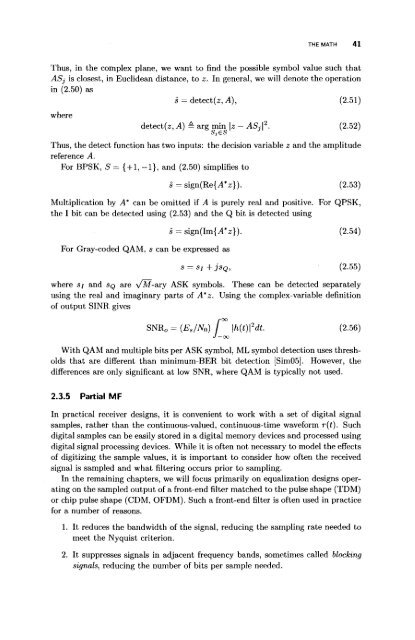mohatta2015.pdf
signal processing from power amplifier operation control point of view
signal processing from power amplifier operation control point of view
Create successful ePaper yourself
Turn your PDF publications into a flip-book with our unique Google optimized e-Paper software.
THE MATH 41<br />
Thus, in the complex plane, we want to find the possible symbol value such that<br />
ASj is closest, in Euclidean distance, to z. In general, we will denote the operation<br />
in (2.50) as<br />
s = detect(z, A), (2.51)<br />
where<br />
detect(«, A) = arg min \z - ASj\ 2 . (2.52)<br />
Thus, the detect function has two inputs: the decision variable z and the amplitude<br />
reference A.<br />
For BPSK, S = { + 1, -1}, and (2.50) simplifies to<br />
s = sign(Re{yTz}). (2.53)<br />
Multiplication by A* can be omitted if A is purely real and positive. For QPSK,<br />
the I bit can be detected using (2.53) and the Q bit is detected using<br />
For Gray-coded QAM, s can be expressed as<br />
s = sign(Im{.4*z}). (2.54)<br />
s = s¡+js Q , (2.55)<br />
where s¡ and SQ are \/M-ary ASK symbols. These can be detected separately<br />
using the real and imaginary parts of A*z. Using the complex-variable definition<br />
of output SINR. gives<br />
\h(t)\ 2 dt. (2.56)<br />
/<br />
■oo<br />
With QAM and multiple bits per ASK symbol, ML symbol detection uses thresholds<br />
that are different than minimum-BER bit detection [Sim05]. However, the<br />
differences are only significant at low SNR, where QAM is typically not used.<br />
oo<br />
2.3.5 Partial MF<br />
In practical receiver designs, it is convenient to work with a set of digital signal<br />
samples, rather than the continuous-valued, continuous-time waveform r(i). Such<br />
digital samples can be easily stored in a digital memory devices and processed using<br />
digital signal processing devices. While it is often not necessary to model the effects<br />
of digitizing the sample values, it is important to consider how often the received<br />
signal is sampled and what filtering occurs prior to sampling.<br />
In the remaining chapters, we will focus primarily on equalization designs operating<br />
on the sampled output of a front-end filter matched to the pulse shape (TDM)<br />
or chip pulse shape (CDM, OFDM). Such a front-end filter is often used in practice<br />
for a number of reasons.<br />
1. It reduces the bandwidth of the signal, reducing the sampling rate needed to<br />
meet the Nyquist criterion.<br />
2. It suppresses signals in adjacent frequency bands, sometimes called blocking<br />
signals, reducing the number of bits per sample needed.



